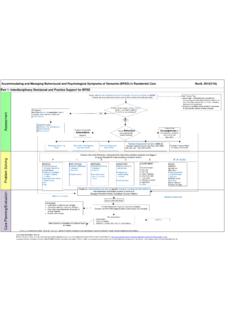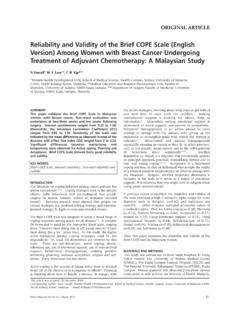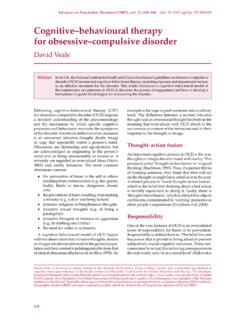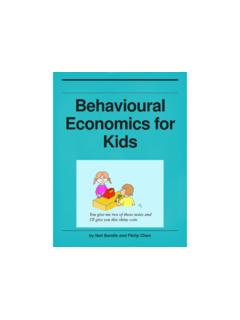Transcription of ZÀ]}µ o À }v - TalkPlus
1 behavioural A ivaion behavioural Activation behavioural Activation is an evidence based intervention for the treatment of low mood or depression, recommended by the National Institute for Health and Clinical Excellence (NIHCE, 2009). This workbook can be used either alone or with the support of your Psychological Wellbeing Practitioner. How to use this workbook. behavioural Activation has four steps. It is important to work through one step at a time, only move on to the next step of behavioural Activation once you are comfortable with using the previous step. It is key to follow all four steps of behavioural Activation in sequence. It can take some time for an intervention to become effective and to show improvement. It is important to allow enough time for behavioural activation to be effective. Evidence of Effectiveness; Helpful Resources; A Recovery Programme for Depression, by Lovell and Richards behavioural Strategies for Managing Depression Becoming More Active O ercoming Depression and Low Mood, by Chris Williams behavioural Activation Tackling Withdrawal in Low Mood behavioural Activation is an evidence based treatment used to tackle withdrawal from day to day activities in low mood.
2 It works by identifying the activities that we may lack the motivation or interest to do when we are feeling low, or when we find we have little time for ourselves. These activities are then gradually reintroduced to incorporate structure, enjoyment and a sense of achievement back into our daily lives. When we are feeling low in mood, we may find it difficult to carry out everyday activities and so find ourselves withdrawing and avoiding these activities. For example, we may avoid seeing friends, stop doing the washing and put off paying bills because we lack motivation or find them overwhelming. Initially the pressure could make us feel that avoiding the activity would be a better solution, however, the longer we avoid, the more difficult it becomes to build the routine up again. The Vicious Cycle of Low Mood By withdrawing from activities, such as seeing friends, paying bills and household tasks, we lose out on experiencing achievement, connectedness to others and enjoyment.
3 The Vicious Cycle of Low Mood shown above demonstrates how the things that we do or don t do because we feel low may result in maintaining the way we are feeling. behavioural Activation breaks the vicious cycle by gradually reintroducing activities, which has a positive effect on the way we feel. There are four steps to behavioural Activation. STEP ONE Identifying Activities The first step of behavioural Activation is to identify activities that you think you re not doing. These may be things you used to do but no longer find pleasure in, or those that you seem to have little time in your week to do. You can also include activities that you have always wished to do but have never had the motivation to begin. Activities can be broken up into three separate categories; routine, necessary and pleasurable.
4 Evidence shows that in order to have a healthy balance of mood we should include these three main types of activities as part of our weekly routine. Routine Activities Activities that are done day to day to make our lives more comfortable. Such as; washing, housework, preparing food and exercise. Necessary Activities Activities that are essential and the longer we leave them the worse the negative consequences. Such as; paying bills, applying for jobs, booking medical appointments. Pleasurable Activities Activities that give a sense of achievement or connectedness to others and improve our quality of life. Such as; seeing friends, hobbies, gardening, sports. When we feel low or lack motivation sometimes it can be difficult for us to recall what we used to do and enjoy before we were feeling this way. Below is a list of example activities which may help to identify the activities you may not be doing.
5 Categorising activities can be very individual so you may find some of the examples fit into different categories for you. Rouine A iviies Washi g the dishes Eai g a healthLJ eal Hoo eri g Washi g the ar Regular edi e Goi g to the gLJ Doi g the lau drLJ Ne essary A iviies PaLJi g ills Book a Drs appoi t e t Food shoppi g Tad i g the ar Updai g CV Book a De ist appoi t e t Perso al are Pleasura le A iviies Seei g frie ds Lear i g a e skill Garde i g Si gi g i hoir Taki g a ath Walki g the dog Baki g a ake To complete Step 1 use Worksheet 1. Fill in the worksheet with activities you have withdrawn from in the three different categories. WORKSHEET ONE Identifying Activities Routine Activities Necessary Activities Pleasurable Activities STEP TWO Ranking Activities The second step of behavioural Activation is to rank activities in order of how difficult they would be to carry out currently.
6 Think of which activities would be easiest to do, or most difficult to carry out depending on your mood. behavioural Activation works best if it is graded, only carry out activities to begin with that you feel are achievable, before moving on to activities that may be more difficult. Activities are ranked into three separate levels of difficulty; easy, moderate and difficult. These levels of difficulty will be individual to you. It can sometimes be hard to find the time or build up these activities after a long period of withdrawing from them. Therefore it is important to work out which activities are going to be easier for you to carry out first, then you can slowly working towards those activities you may find more difficult. Whilst ranking the activities it is important to include at least one pleasurable, routine and necessary activity in each category to ensure a healthy balance of each is carried out.
7 For example; Easy Activities Routine: Mopping the bathroom Necessary: Find gas bill Pleasurable: Call a friend Moderate Activities Routine: Wash the car Necessary: Arrange a Dentist appointment Pleasurable: Go for lunch with a friend Difficult Activities Routine: Go to the gym Necessary: Monthly food shop It may be difficult initially to think of easier activities to complete, some ideas to help are; Ask a friend or family member to help. Break larger tasks down into more manageable steps, Clean the house can be broken down into smaller tasks, such as dust the living room for twenty minutes . No activity is too small to start with, Listen to a voicemail message. To start with, maybe aim for completing 10 minutes of a task rather than the whole activity in one go. To complete Step 2 use Worksheet 2. Fill in the worksheet with activities from Worksheet 1 into the levels of difficulty, indicate which category of activity they are.
8 WORKSHEET TWO Ranking Activities Easy Activities Routine Necessary Pleasurable Difficult Activities Routine Necessary Pleasurable Moderate Activities Routine Necessary Pleasurable STEP THREE Scheduling Activities The third step of behavioural Activation is planning into a diary the activities identified in steps 1 and 2 as many people find when an activity is planned and scheduled it is more likely that they will actually complete it. By planning a range of activities, from all three categories, we gradually reintroduce routine, a sense of achievement and pleasure back into our daily lives. Graded. It can be very difficult to find the motivation to begin carrying out activities after a period of withdrawing from them, therefore it is important to start with activities from the Easy Activities table in Step 2, before moving onto moderate or more difficult activities.
9 Balanced. Evidence shows that a balance of different types of activities, routine, necessary and pleasurable, is best for our mood. When planning activities into the diary ensure a mix of the three categories are incorporated so that balance is achieved. For some people it may be that they are not engaging in any pleasurable activities due to feeling all their time is occupied by routine or necessary activities. It may be that the diary can be used to prioritise which activities are most essential and ensure some pleasurable activities are included. Specific. The more specific we are when scheduling in activities to complete the more likely it is that we will complete that activity. Therefore the diary used in Step Three is specially designed to enable you to plan these activities into your week in detail, by asking you to include; What: Be specific about what activity you will be carrying out.
10 When: The exact time and duration of the chosen activity. Where: What locations will you be in while carrying out the activity. Who: Whether you will be alone or with others while completing the activity. Clean worktops at 4:30pm in the kitchen by myself. Fill out your diary. The final part of Step 3 is to begin filling out a diary sheet, keeping in mind the three conditions above. It is very important not to over fill the diary at the beginning, as the activities you put in the diary should be achievable in your current mood. Throughout the weeks you can start to fill the diary up more as your mood improves. To complete Step 3 use Worksheet 3. Fill in the diary following the conditions above. Date: Morning What Where When Who Mood efore: Mood ater: Aternoon What Where When Who Mood efore: Mood ater: Evening What Where When Who Mood efore: Mood ater: WORKSHEET THREE Scheduling Activities STEP FOUR Implementation & Monitoring The final step of behavioural Activation is to complete the activities you have planned into your diary.













